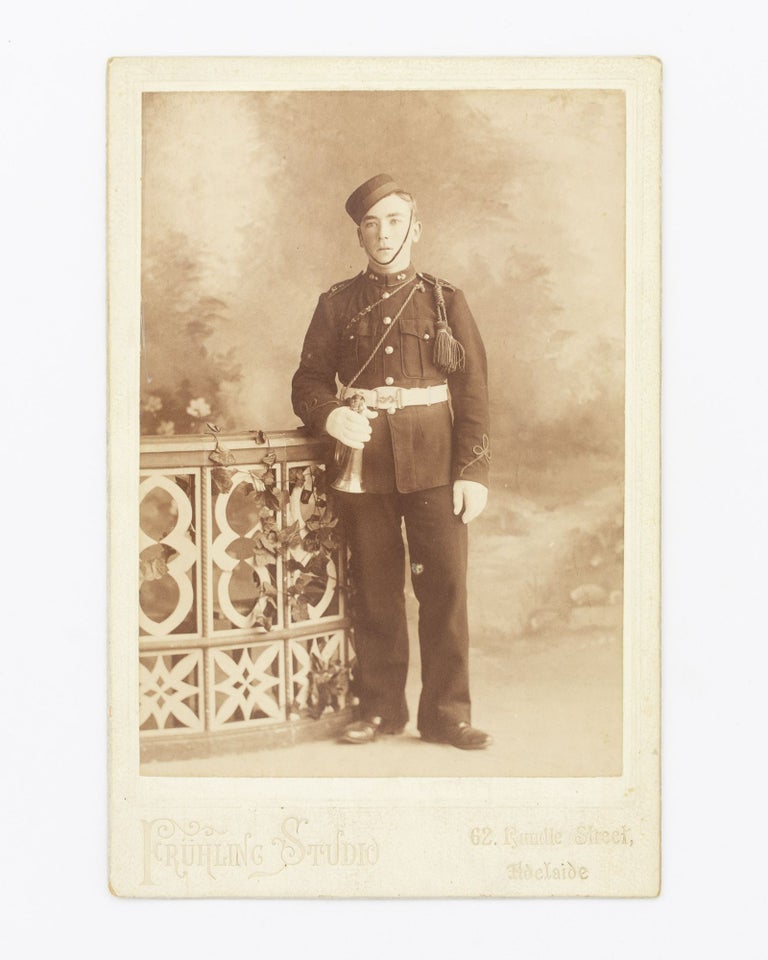
A South Australian cabinet card photograph of a man in military uniform holding a bugle
Adelaide, Fruhling Studio, 62 Rundle Street, [mid- to late-1890s].
A vintage gelatin silver photograph (134 × 94 mm), mounted on the original cabinet card (165 × 110 mm), with the photographer's details blindstamped in the bottom margin.
Both the photograph and mount are in excellent condition.
Contemporary business directories indicate that Fruhling Studio commenced operating from 62 Rundle Street in 1895 ('Portrait and Enlarging Co., Fruhling & Co.'); this 'continued until 1913, when the address was changed to 62A Rundle Street. From 1918 to 1927 the address was given as 103A Rundle Street. Although listed as Fruhling & Co. in directories, the name Fruhling Studios [sic] was usually printed on their photographs' (Photohistory SA website). The particulars of the uniform elude us, but the following information about the parlous state of military affairs in colonial SA at the time this photograph was taken, provides some context. These comments come from an unpublished manuscript by Geoffrey H. Manning ('The Russians are Coming - The Defence of Colonial South Australia'), now in the State Library of SA. 'By May of 1896 it was finally recognised that the basis upon which the military forces of the Australian colonies were organised was unsatisfactory and it was to cure defects and place matters on a more effective footing that a Consolidating and Amending Act had been passed in the previous session. In the dying days of Parliament its progress through all stages was pushed on and the headlong speed, with which it was carried through the two chambers, necessarily militated against the critical examination of its many clauses.The fact that the majority of the sections were merely repetitions of those in existing Acts was obviously no justification for dealing with the Bill in such a spasmodic manner. After the Act was assented to more than four months were allowed to pass without anything being done to bring the members of the old force together, with a view to acquainting them with the conditions under which they were to be asked to enroll and this policy of procrastination was observed to the last.... Enrolment commenced in August but in the face of the many other allurements held out to the youth of South Australia in the form of cricket, football, baseball, lacrosse, and - most attractive of all - cycling, it was not to be wondered that the process of recruiting was painfully slow; by mid-February 1897 there had been 611 enrollments. With this change came the end of the colourful uniforms that marked the early military history of the colony. The scarlet tunics, white-striped blue trousers and white helmets that had followed the grey uniform of the 1880s - the "Destitutes" they called the men in these uniforms - were replaced by khaki with maroon facings and a felt hat. The first parade of the new military forces took place on 3 October 1896 when "The South Australian Army" presented a rather nondescript appearance owing to the fact of so many recruits being in the ranks and yet unprovided with uniforms, and also a proportion of men in the old force whose uniforms were worn out and too shabby for wear. The public manifested little interest in the proceedings - it was race-day - and, moreover, the band was not expressively in evidence. A few people, probably the mothers and fathers, the sisters and the aunts of the new recruits, attended'.
Item #128029
Price (AUD):
$250.00
